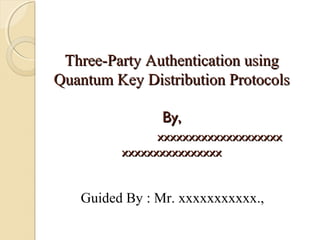
Three-Party Quantum Key Distribution
- 1. Three-Party Authentication using Quantum Key Distribution Protocols By, xxxxxxxxxxxxxxxxxxxx xxxxxxxxxxxxxxxx Guided By : Mr. xxxxxxxxxxx.,
- 2. Abstract This project presents Quantum Key Distribution Protocols (QKDPs) to safeguard security in large networks, by using DES algorithm for encryption and decryption of .txt file. In this project, secure communication between the sender and the receiver is being made possible through a trusted center by using secret key authentication.
- 3. Abstract continued… The Trusted Center distributes a quantum key to both the sender and the receiver after the verification of the secret key. The sender encrypts the data and sends to the receiver side only after obtaining the quantum key from the Trusted Center. Similarly the decryption process occurs. RSA algorithm is being used for quantum key distribution. Finally the input .txt file is retrieved on the receiver side.
- 4. Existing System In classical cryptography, three-party key distribution protocols utilize challenge response mechanisms or timestamps to prevent replay attacks . However, challenge response mechanisms require at least two communication rounds between the TC and participants.
- 5. Demerits of Existing System The timestamp approach needs the assumption of clock synchronization which is not practical in distributed systems. Furthermore, classical cryptography cannot detect the existence of passive attacks such as eavesdropping.
- 6. Proposed System In quantum cryptography, quantum key distribution protocols (QKDPs) employ quantum mechanisms to distribute session keys and public discussions to check for eavesdroppers and verify the correctness of a session key. However, public discussions require additional communication rounds between a sender and receiver and cost precious qubits. By contrast, classical cryptography provides convenient techniques that enable efficient key verification and user authentication. The advantages of both the classical and quantum cryptography are utilized in the proposed QKDP.
- 7. Working Principle In Proposed System, the sender and the receiver preshared their secret key to the Trusted Center (TC). In Trusted Center session key is generated by using secret key and random string then quantum key is generated through qubit generation. To generate the quantum key using the qubit and the session key which depends on the qubit combination such as, 1. If the value is 0 and 0, then 1/0.707(p[0]+p[1]) 2. If the value is 1 and 0, then 1/0.707(p[0]-p[1]) 3. If the value is 0 and 1, then p[0] 4. If the value is 1 and 1, then p[1]
- 8. System Requirements Hardware Requirements Processor RAM capacity Hard Disk - Intel Pentium III 128 MB 40 GB Software Requirements Operating System Front End Back End - Windows XP Visual C# .Net SQL Server 2000
- 9. List of modules 1. Sender Module. 2. Trusted Center Module and 3. Receiver Module.
- 10. Module Description Sender Module This module has three sub-modules. They are, 1. Registration 2. Login 3. Send data
- 11. Modules Continued… Trusted Center Module Secret Key Verification Session Key Generation Qubit Generation Quantum Key Generation Key Distribution
- 12. Modules Continued… Receiver Module This module has three sub-modules. They are, 1. Registration 2. Login 3. Receive data
- 13. Use case Diagram – Quantum key Generation
- 14. Algorithms For Encryption & Decryption, DES algorithm is used. For key Generation RSA algorithm is used, the algorithms are explained as,
- 15. DES algorithm
- 16. RSA algorithm Key Generation 1. Select p ,q where both p and q both prime, p≠q 2. Calculate n=p*q 3. Calculate Ø(n)=(p-1)(q-1) 4. Select integer e where gcd (Ø(n),e)=1; 1<e<Ø(n) 5. Calculate d where d= e^-1 mod Ø(n) 6. Public key KU={e ,n} 7. Private key KR={d ,n}
- 17. Registration form - Sender
- 18. Secret key Generation - Sender
- 19. After Registration - Sender
- 20. Login form - Sender
- 21. Trusted Center
- 23. Secret Key Generation - Receiver
- 24. After Registration - Receiver
- 25. Login form - Receiver
- 26. Quantum Key Generation (After both sender and receiver logged in)
- 27. Path name of the .txt file and the Ip address of the local system
- 28. Data to be Encrypted
- 29. After Encryption
- 30. Data to be decrypted
- 31. After Decryption
- 32. Original Data
- 33. Conclusion Compared with classical three-party key distribution protocols, the proposed QKDPs easily resist replay and passive attacks. Compared with other QKDPs, the proposed schemes efficiently achieve key verification and user authentication and preserve a long-term secret key between the TC and each user. Additionally, the proposed QKDPs have fewer communication rounds than other protocols. Although the requirement of the quantum channel can be costly in practice, it may not be costly in the future. Moreover, the proposed QKDPs have been shown secure under the random oracle model. By combining the advantages of classical cryptography with quantum cryptography, this work presents a new direction in designing QKDPs.
- 34. Future Enhancements The whole project can be enhanced for secure communication between two systems in a local area network through the trusted center which can be a third system in the local area network. The communication round between the sender and the receiver becomes one by applying this project as well as secret key authentication is being provided by the trusted center which in turn generates the quantum key.
- 35. References G. Li, “Efficient Network Authentication Protocols: Lower Bounds and Optimal Implementations,” Distributed Computing, vol. 9, no. 3, pp. 131-145, 1995. A. Kehne, J. Schonwalder, and H. Langendorfer, “A Nonce-Based Protocol for Multiple Authentications,” ACM Operating Systems Rev., vol. 26, no. 4, pp. 84-89, 1992. M. Bellare and P. Rogaway, “Provably Secure Session Key Distribution: The Three Party Case,” Proc. 27th ACM Symp. Theory of Computing, pp. 57-66, 1995.
- 36. THANK YOU
